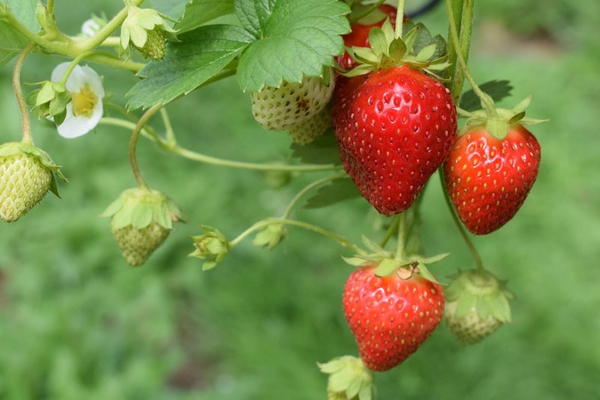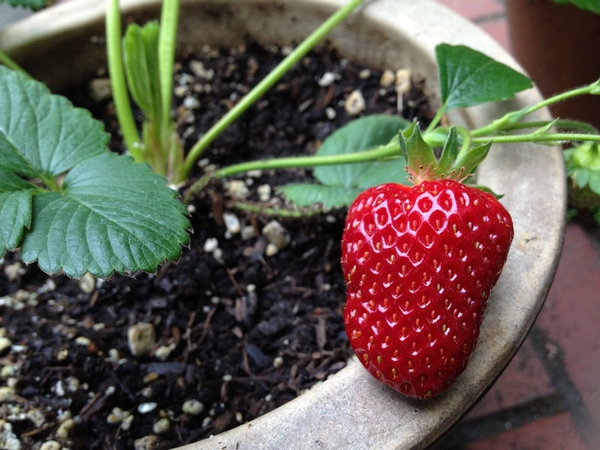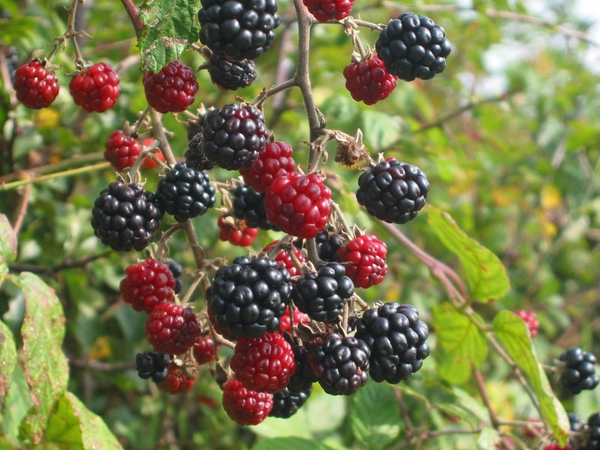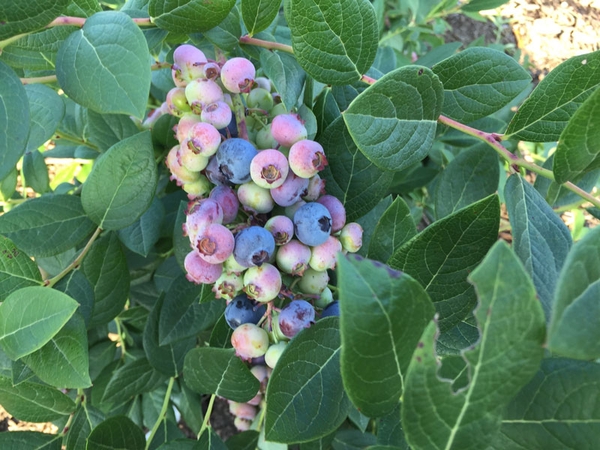The fruits listed below thrive with little maintenance in North Carolina and have few pest and disease problems. Prior to planting, remove weeds, and add organic matter to improve water movement. Use the soil and nutrients recommended by soil test results. After planting, remove all flower buds and water well. Cover the planting area with a 3- to 5-inch-deep layer of mulch. Be sure to keep mulch at least 3 inches away from the base of the plant. The links below provide detailed information.
Ground Cover
Strawberries
Select: June-bearing cultivars such as ‘Galletta’, ‘Chandler’, and ‘Jewell’.
Plant: Between October and March, plant in full sun or light shade. Space 1.5 to 2 feet apart.
Manage: One month after planting, and again in late August, add the equivalent of 2 teaspoons of fertilizer with 16 percent nitrogen to each plant. Apply 4 inches from the crown. Manage weeds by keeping plants mulched, hoeing, and pulling by hand. Protect blossoms from late frost by covering them with a floating row cover or cloth blanket to hold the heat in overnight.
Harvest: Begins late April through May. Beginning 30 days after bloom, harvest fully red berries in the morning, every other day. Each plant may produce up to a quart of berries.
Life Expectancy: One year. Each year after harvest, remove existing plants and grow new plants in a different location to prevent the buildup of diseases and pests in the soil.
Shrubs
Blackberries
Select: ‘Freedom’ is an everbearing, thornless, erect cultivar that does not require a trellis. It fruits on new shoots (primocane) so it can be cut to the ground each fall, making it much easier to manage than other types of blackberries.
Plant: In spring, plant in full sun to light shade 6 feet apart.
Manage: Pruning — In the spring, once the canes are 36 inches high, cut 3 inches off the tip to cause them to branch.
In the late winter, if you are growing ‘Freedom’, remove all canes. If you are growing another cultivar, remove all dead canes and all but the six most vigorous live canes. Prune lateral branches to 1.5 feet in length. Remove all suckers more than 1 foot from the base of the plant.
Fertilizing — Apply 0.5 ounce of nitrogen per bush per year. Apply half in spring and half in summer, just after harvest. Spread the fertilizer in a 12-inch radius around the base of the plant.
Harvest: Early summer when the berry turns dull black. Average yield is 4 pounds per plant.
Life Expectancy: Eight years.
Blueberries
Harvest: Include more than one cultivar for cross-pollination. Extend your harvest by selecting two early, two mid-, and two late-ripening cultivars. In the mountains, select Highbush varieties (‘Duke’, ‘Sunrise’, ‘Echota’, ‘Blueray’, ‘Elliott’, and ‘Aurora’). In the piedmont, choose Rabbiteye varieties (‘Climax’, ‘Premier’, ‘Ira’, ‘Tifblue’, and ‘Powderblue’). In the coastal plains, choose Highbush and Southern Highbush (‘O’Neal’, ‘Duke’, and ‘Legacy’).
Plant: Full sun in soil with pH less than 5.0. Do not try to grow in soil with pH over 6.0. Blueberries do best in soils that are high in organic matter with good drainage. Do not plant in heavy clay soil. Install 6 feet apart. Prune the plant to remove all but the three or four strongest shoots.
Manage: Protection from birds may be necessary. Prune in winter, and remove 1/3 of the plant each winter based on these priorities:
- At the ground level, remove all stems more than 15 inches from the base of the plant.
- At the point of attachment, remove all dead stems, all stems crossing back to the middle, and all low horizontal stems.
- Remove up to three older stems from the middle.
- Remove leggy, repeatedly branched stems.
Harvest: Two months after bloom. Allow fruit to fully ripen before picking (three to six days after turning blue). The average yield for a mature bush is 1 to 2 pounds per year.
Life Expectancy: Twenty-five years.
Trees
Figs
Select: ‘Celeste’, ‘Brown Turkey’, and ‘Marseille’. Select more than one cultivar to extend the harvest.
Plant: Plant in full sun, 10 feet apart. Install in late fall or early winter. Dig a hole twice as wide and only as deep as the root system. Place the root system in the center of the hole. Fill the hole with native, unamended soil, water well, and cover the entire planting area with a 3- to 5-inch-deep layer of mulch, keeping the mulch 3 to 5 inches from the trunk of the tree.
Manage: After harvest, prune to manage plant size.
Harvest: June to August, when the fruit turns color (varies with cultivar). Remove figs with the stems attached. Picked fruit lasts only a few days. Fig trees produce two harvests each year.
Paw Paws
Select: ‘Allegheny’, ‘NC-1’, ‘Overleese’, ‘Potomac’, ‘Shenandoah’, ‘Sunflower’, ‘Susquehanna’, and ‘Wabash’. Include more than one cultivar for cross-pollination.
Plant: In the late fall or early winter, plant in full sun. Dig a hole twice as wide and only as deep as the root system. Place the root system in the center of the hole. Fill the hole with native, unamended soil, water well, and cover the entire planting area with a 3- to 5-inch-deep layer of mulch, keeping the mulch 3 to 5 inches from the trunk of the tree.
Manage: In late winter, remove dead, damaged, and crossing branches.
Harvest: August to September, when fruit begins to soften and has a fruity, floral aroma. Fruit will continue to ripen after being picked.
| Plant Type | Plant | Jan | Feb | Mar | Apr | May | Jun | Jul | Aug | Sep | Oct | Nov | Dec | ||||||||||||
|---|---|---|---|---|---|---|---|---|---|---|---|---|---|---|---|---|---|---|---|---|---|---|---|---|---|
| Ground Covers | Strawberries | X | X | X | X | ||||||||||||||||||||
| Bushes | Blackberry | X | X | X | X | X | X | ||||||||||||||||||
| Blueberry | X | X | X | X | |||||||||||||||||||||
| Trees | Fig | X | X | X | X | X | X | ||||||||||||||||||
| Pawpaw | X | X | X | X | |||||||||||||||||||||

Figs are deciduous small trees that can be espaliered against a wall or fence for easy harvesting.
Doug McAbee CC BY-NC 2.0
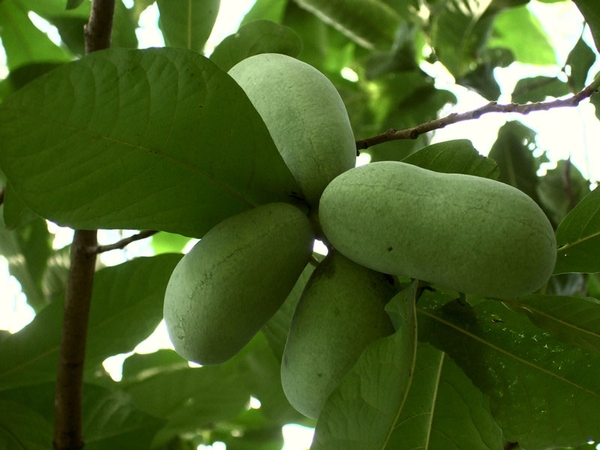
Paw paws are small, deciduous trees native to North Carolina. The edible, sweet-tasting, custard-like fruit is 2.5 to 6 inches long.
Wendell Smith, Flickr CC BY 2.0
Fun With Fruits
Books
- Baby, Let’s Eat by Stephan Lomp
- Eating the Alphabet by Lois Ehlert
- Planting a Rainbow by Lois Ehlert
Videos
- "Oliver's Fruit Salad." Learning Tree T.V. June 14, 2019. Video.
- "Fruit Bowl by Mark Hoffman." Follow the Readers. February 5, 2021. Video.
Activities
Additional Resources
- The Natural Learning Initiative
- NC State Extension Horticulture
- North Carolina Extension Gardener Handbook
- Chapter 14: Small Fruits
- Chapter 15: Tree Fruits and Nuts
- NC State Extension Gardener — fruit
- NC State Extension Gardener Plant Toolbox — edible plants
- NC State Department of Horticultural Science — growing fruits
- NC State Extension Fruit Publications
- Food Safety in the Garden (PDF, 3.6 MB)
- How to Create a Container Garden for Edibles in the North Carolina Piedmont, NC State Extension publication AG-753
- Container Garden Planting Calendar for Edibles in the Piedmont, NC State Extension publication AG-748
- Garden Help Directory — Contact the local N.C. Cooperative Extension center in your county.
- North Carolina Extension Gardener Handbook
- Wake Smart Start
- Growing Minds, a program of the Appalachian Sustainable Agriculture Project
- Farm to Preschool (lesson plans, toolkit, “this week in the garden,” take-home information for parents
- Children’s Literature Bookshelf, Growing Minds
- Farm to School, a program of the Appalachian Sustainable Agriculture Project
Acknowledgments
Funding for this publication was provided in part by the John Rex Endowment.
The authors would like to thank Melissa Bell, Research Associate, Center for Environmental Farming Systems Field Research, Education and Outreach Liaison, NC State University, for their management of the review process.
This publication was developed in partnership with the Natural Learning Initiative in the College of Design at North Carolina State University.
About the Local Foods Series: Childcare Center Production Gardens
This publication in the Local Foods series is one of 15 publications about childcare center production gardens:
- Growing and Cooking Fruits and Vegetables at Childcare Centers (LF-007-01)
- Creating Childcare Center Production Gardens (LF-007-02)
- Growing Warm-Season Fruits and Vegetables in Childcare Production Gardens (LF-007-03)
- Growing Cool-Season Vegetables in Childcare Production Gardens (LF-007-04)
- Snacking and Cooking with Warm-Season Produce from Childcare Production Gardens (LF-007-05)
- Snacking and Cooking with Cool-Season Produce from Childcare Production Gardens (LF-007-06)
- Composting in Childcare Center Production Gardens (LF-007-07)
- Vermicomposting in the Childcare Center Production Gardens (LF-007-08)
- Introducing Children to Insects in Childcare Center Gardens (LF-007-09)
- Easy Fruits to Grow at Childcare Center Gardens (LF-007-10)
- Growing Strawberries in Childcare Center Gardens (LF-007-11)
- Managing Weeds in Childcare Center Gardens (LF-007-12)
- Growing Fruit Trees in Childcare Center Gardens (LF-007-13)
- Growing Muscadines in Childcare Center Gardens (LF-007-14)
- Growing Blueberries in Childcare Center Gardens (LF-007-15)
Publication date: July 24, 2023
LF-009-10
N.C. Cooperative Extension prohibits discrimination and harassment regardless of age, color, disability, family and marital status, gender identity, national origin, political beliefs, race, religion, sex (including pregnancy), sexual orientation and veteran status.

